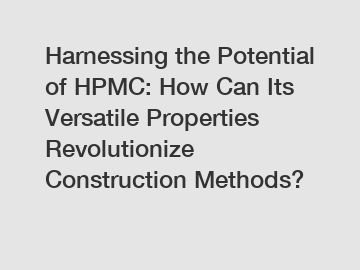Dec. 07, 2023
Construction
Harnessing the Potential of HPMC: How Can Its Versatile Properties Revolutionize Construction Methods?
In the field of construction, the search for innovative construction materials that can enhance durability, sustainability, and efficiency has always been a top priority. Hydroxypropyl Methylcellulose (HPMC) is one such material that has gained attention in recent years due to its versatile properties. From improving cement mortars and plastering to providing lightweight insulation, HPMC has the potential to revolutionize construction methods. In this article, we will explore the various applications of HPMC and its role in shaping the future of construction.
Improved Cement Mortars: Strengthening the Foundation.

HPMC is commonly used to improve the performance of cement mortars. It acts as a rheology modifier, offering better workability and reducing the risk of segregation and bleeding. The addition of HPMC in cement mortars can enhance the adhesion properties, making them less prone to cracking and improving overall durability. The controlled water retention of HPMC also ensures optimal curing, resulting in stronger and more reliable structures.
Versatile Plastering: Enhancing Aesthetics and Performance.
Plastering is an essential step in construction, providing both functional and aesthetic benefits. HPMC is widely used in plastering to improve workability, adhesion, and sag resistance. It helps bind the plaster to the surface, reducing the chances of delamination or cracking. HPMC also improves the spreadability of plaster on various substrates, resulting in a smooth and uniform finish. Furthermore, HPMC's water retention properties enable gradual curing, preventing premature drying and enhancing the overall quality of the plaster.
Lightweight Insulation: Enhancing Energy Efficiency.
Suggested reading:Energy efficiency has become a paramount concern in construction. HPMC plays a vital role in enhancing the thermal insulation of buildings. When HPMC is added to lightweight insulation materials, such as expanded polystyrene or mineral wool, it helps improve their adhesion. This ensures a seamless and consistent layer of insulation, reducing thermal bridging and enhancing overall energy efficiency. HPMC also acts as a binding agent, improving the compressive strength and longevity of the insulation material.
Revolutionizing Construction Techniques:
Apart from its specific applications, the versatile properties of HPMC open up opportunities for innovative construction techniques. HPMC can be used in 3D printing of intricate structures, allowing for greater design freedom and faster construction. Its ability to control water retention also makes HPMC suitable for self-healing concrete, where cracks are automatically repaired through the hydration process. Additionally, HPMC can be used as a binder in the production of eco-bricks, reducing the need for traditional, energy-intensive clay bricks.
Conclusion:
The potential of HPMC in revolutionizing construction methods cannot be underestimated. Its versatile properties make it an invaluable material that improves cement mortars, enhances plastering, boosts energy efficiency, and opens doors for innovative construction techniques. As researchers and developers continue to explore the possibilities, the use of HPMC is expected to grow in the construction industry.
To learn more about the applications of HPMC in construction and how it can transform your projects, contact us today. Our team of experts will be happy to assist you in harnessing the full potential of this remarkable material.
If you want to learn more, please visit our website skim coat wall putty, chemical raw material rdp, china hpmc-hydroxypropyl methyl cellulose supplier.
Further reading:Related Articles
If you are interested in sending in a Guest Blogger Submission,welcome to write for us!
All Comments ( 0 )